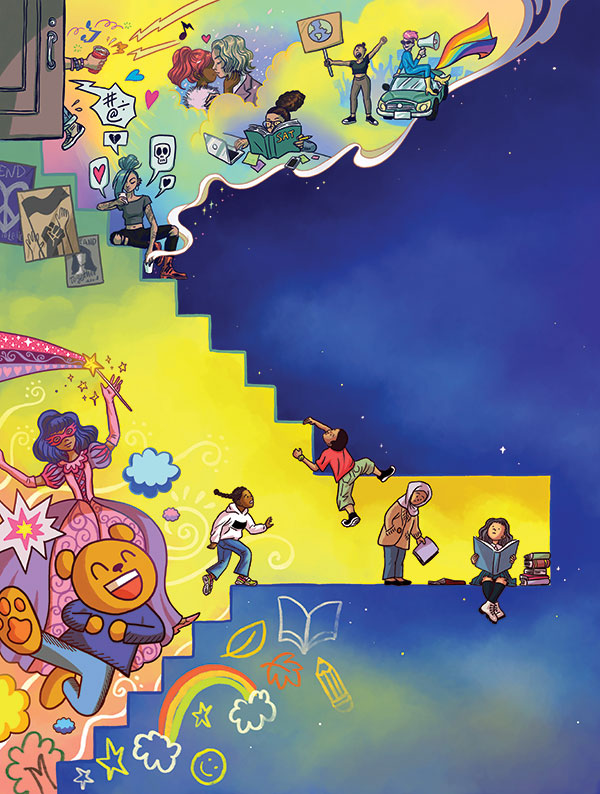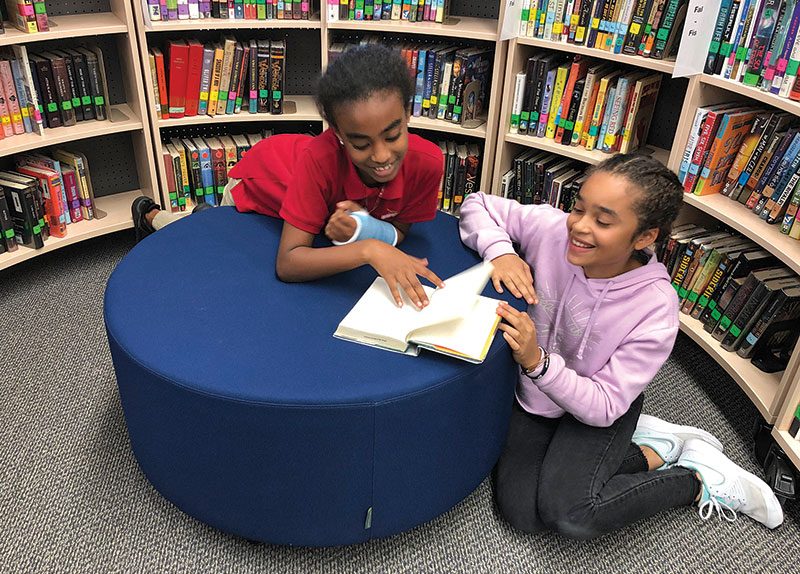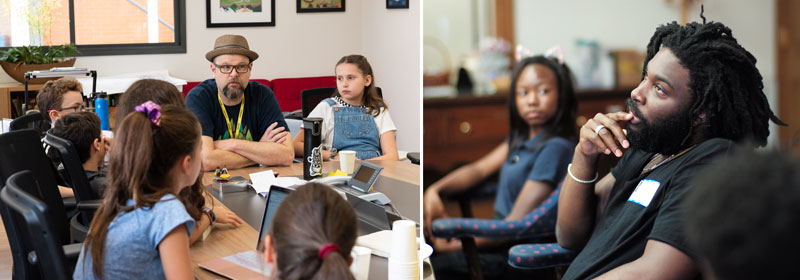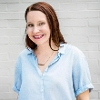Middle Grade Is too Young, YA too Old. Where Are the Just-Right Books for Tweens?
Librarians and publishers address a demand for more tween-centric reads.
Also read: |
Angie Thomas took to Twitter recently to address an issue that librarians have long lamented: Where’s the category for tween readers?
“Trying to decide if I’ll do Middle Grade Fantasy or YA Fantasy even though I’d really like to write it for that ‘in between’ age that publishing doesn’t seem to recognize,” tweeted Thomas, best-selling author of The Hate U Give and On the Come Up. A cascade of comments followed, as educators, librarians, and authors urged her to write for this crossover age group, in part because many librarians see a dearth of titles for tweens and young teens.
 |
Illustration by Yao Xiao |
“There are some fabulous books being published that are aimed at maybe the fourth, fifth, sixth grade, or third through sixth grade reading level,” says Cheri Dobbs, middle school librarian at Detroit Country Day School in Beverly Hills, MI, who commented on Thomas’s tweet. “But [for] those seventh graders, the solidly in-the-middle-of-middle-school readers, I struggle to find the best thing for them.”
For students around ages 11 to 14, middle grade titles aren’t always a good fit. The terminology can be confusing—middle grade doesn’t equal middle school. Most middle grade books are designated by publishers for ages eight to 12, while middle school students range in age from 10 to 15. According to the U.S. Census Bureau, in 2018 there were approximately 20.8 million 10-to-14-year-olds in the United States, or 6.4 percent of the population.
Marcia Kochel, teacher librarian at Druid Hills Middle School in Decatur, GA, finds that most middle grade titles are “sweet, poignant stories,” often with a message or lesson. “Tweens want more intense action and conflict than they will get in a middle grade book,” she says. “Those just don’t deliver the complexity, action, and edginess they are wanting.”
Middle school kids also want a bigger reach—beyond school and family and their known world, Kochel adds. “When I do booktalks, kids gravitate toward shocking topics. For example, if I say a book is about a school shooting, or an alien invasion, or a mysterious plane crash, kids will pick it up,” she says. “Many middle schoolers are looking for horror books that are actually scary, and it can take a lot to scare a middle school kid.”
Meanwhile, as YA fiction has grown in the past 20 years, and as adults increasingly read YA, the category has focused more on older teen characters, sometimes following them into and after college and bordering on adult fiction. Where does that leave actual teens and tweens?
What about YA?
Since May, Andrea Sowers, teen outreach librarian at the Joliet (IL) Public Library, has kept track of the ages of the protagonists in the YA and middle grade books that cross her desk. In YA, she says, only three percent of stories have main characters under 16. At the same time, “there are double the amount of books in YA fiction about characters who are out of high school, maybe in college, than there are 12-to-15-year-olds. I think that’s a huge problem.” Sowers found more 12-year-old characters in middle grade, but only 16 percent of those titles have protagonists who are 13 or 14.
Teen titles without cursing or sexual subject matter are sometimes referred to as “clean teen,” shorthand that has been criticized for implying that language and sex are inherently immoral. Debates over morality aside, YA books can contain characters and themes that just aren’t as relevant to middle school lives.
“At 16, you’re probably driving, you’ve probably got an after-school job, you’re really into romance maybe,” Sowers says. “You hit certain plateaus in high school that you’re not hitting quite yet in middle school. Kids are talking about college, and most 13-year-olds aren’t thinking about college quite yet…you’re focusing on what a 16-year-old would do.”
While publishers label many YA books as appropriate for ages 12 and older, including the best sellers Everything, Everything by Nicola Yoon and To All the Boys I’ve Loved Before by Jenny Han, some librarians find that younger students in this range may not be interested in reading about romance and relationships, which are the main plotlines in those titles.
“I love Nicola Yoon and Jenny Han, but some of the things that our patrons are asking for reveal they maybe want less grown-up [fare],” says Michelle Ehrich, young adult specialist at Greene County (VA) Library.
Even for advanced readers, the most popular YA titles are more intense than what some librarians would hand to a 12- or 13-year-old, while in middle grade, there’s an emphasis on solid fifth grade books, says Dobbs. In YA, the focus is on “gritty and intense” stories.
“I love The Poet X, I love The Hate U Give, All American Boys. I love some rom-coms, like those by Jennifer E. Smith,” she says. “But what to do with the seventh grader is always my question.”
While a book’s topics may be of interest, many librarians find that YA titles, which can contain more complicated prose, explicit language, or violent or sexual scenes, skew too old for tween and young teen readers.
 |
The library at Druid Hills Middle School in Decatur, GAPhoto by Patricia Richmond |
“My young adult book club recently read American Street by Ibi Zoboi, which is a great book, and it deals with the immigrant experience and with the mother being detained as she’s trying to come into the country,” Ehrich says. “But there’s so much strong language. I would love to see a book with those themes for a slightly younger reader.”
There are some titles targeted to ages 10 to 14 or 10+, but those are still categorized as middle grade. Amid this crossover age group and confusing terminology, librarians find books to recommend, including those by authors such as Alan Gratz, Jason Reynolds, and Raina Telgemeier.
“I worked in a sixth to eighth grade middle school library and didn’t have trouble finding materials for my students, especially when throwing graphic novels and manga into the mix,” says Carla Riemer, librarian at Albany (CA) High School. “I acquired books from both the middle grade and YA categories, as students in this age group are all over the place in terms of maturity and interest.”
Ehrich struggles with what to offer when she has exhausted her go-to options. “It’s like they get through all of the Rick Riordan and they want something that’s like ‘Percy Jackson,’ and there’s not a lot that’s newer in that genre,” she says.
The way books are categorized, packaged, and marketed can deter tweens, from the designated age range to the cover. “I have a rabid hatred of AR-type labeling systems that pigeonhole children into specific books,” says Erikka Sawdey, a reference librarian at Pickerington (OH) Public Library. “If they don’t like any titles within that particular number, what do we do? Give up, better luck next time? While it would be admittedly useful to have a book declare ‘this is appropriate for tweens’ or ‘for mature teens only,’ this may keep some children from reading books they personally can handle.”
Such age classifications may be more of a hindrance than a help for finding the right titles—both for librarians and for readers.
“The content is out there if we look past the designations publishers assign, and maybe publishers need to allow a bit more flexibility in their marketing strategies,” Riemer says.
Shelving is also a challenge. Some public libraries have a crossover section that includes both middle grade and YA titles. This may help with discoverability, as tweens and teens don’t want to be lumped in with younger kids browsing a juvenile section, or be caught with a book that looks childish.
“Middle grade and teen covers have very distinct feels,” Sowers says. “Even if I feel that a middle grade novel would be a great title for those younger teens, I can’t put it in the teen section because the cover makes it stand out or look babyish.”
Every reader is unique
Readers’ advisory depends on the individual kid, in the end, and no book is a one-size-fits-all solution.
“Recommending books to this age group, which I’ll loosely identify as fifth to eighth grades, you have to strike a delicate balance between reading ability and maturity,” Sawdey says. “This is especially challenging if the children involved are outliers—those who read with very high skill level but are middle schoolers at heart.”
It goes back to knowing your customer. “Let’s say we have a 13-year-old girl who reads on a high ninth grade level,” Sawdey says. “What would keep me from giving that child The Hate U Give? It’s culturally relevant, a modern literary masterpiece, involves a main character roughly her age, and is poignant and touching. Some would say ‘But is she ready at 13?’ I would counter: ‘If she’s not ready now, in this day and age, with this news cycle, when will she be ready?’ ”
Still, a precocious 12-year-old is not the same reader as a 15-year-old, and certainly different from a 17-year-old, though they all may read YA books. Meanwhile, middle school students go through enormous changes in a few short years, and these wide differences in reading interest and comprehension can present a challenge to librarians who have to serve every reader.
“Readers are so incredibly varied,” says Brittany Harrell, a teen services librarian in North Carolina. “Younger students can be more cognitively and emotionally advanced than older students. Older students can be cognitively and emotionally delayed. Because every student is different, their approaches to content and characters are different as well.”
 |
Author Alan Gratz with students at Graded, the American School of São Paulo; Jason Reynolds at the University School of Milwaukee.From left: Photo by Angela Park; Photo by Laura Shipley |
Publisher and librarian solutions
For publishers, age ranges and categories are as much a content determination as a sales and marketing tool, taking into account where libraries and retail outlets will shelve books.
“What gives the book the best opportunity for the greatest readership?” asks Caitlyn Dlouhy, vice president and editorial director of the imprint named after her at Simon & Schuster’s Atheneum division. “What age group will the librarians…most comfortably present a book to? You’re trying to figure out what gives a book the best opportunity, given the age of the characters, what they’re going through, and what the gatekeepers are going to be comfortable with.”
Dlouhy, who edits Jason Reynolds’s books, is looking for titles in the “tween-plus” space, in part to keep kids reading instead of diverting their attention to screens and other activities. Reynolds’s “Track” series is categorized for ages 10 to 14, and some librarians cite his YA title Long Way Down as fitting for this audience. “I’d love to see more in this age group. I feel like that’s the gap where we lose our readers,” Dlouhy says.
Other publishers making efforts in the upper middle grade/young YA area include Blink, a subsidiary of HarperCollins’s Zondervan division of HarperCollins Christian Publishing, which publishes “clean” YA fiction and nonfiction, advertised as “inspiring and heartening while maintaining a tradition of imaginative and exciting storytelling.” Lee & Low Books allows website visitors to search by grade range, including grades 6-8, and offers information on reading level, interest level, and a list of themes for books. Penguin Young Readers makes a point of calling out younger YA in its booth at conferences, according to Carmela Iaria, executive director of school and library marketing/creative marketing director. Some of the publisher’s middle grade books have been placed on YA reading lists, such as Harbor Me by Jacqueline Woodson, which was selected for the 2019 YALSA Best Fiction for Young Adults list.
Scholastic has launched two imprints geared toward tween and young teen readers: Wish and Point Paperbacks. Aimee Friedman, editorial director at Scholastic, oversees both and edits books by Alan Gratz. “I feel passionately about providing books for that age range, because I agree it’s not always the easiest thing to find,” she says.
At Scholastic, narrative voice and themes can affect the age range of a book, though it usually comes down to the age of the characters. If the protagonist is in high school, it’s YA; if they are younger, it’s middle grade. Gratz is an exception in the middle grade world. His most recent title, Allies, tells the story of 17- and 18-year-old soldiers on D-Day, but without graphic content; the book is listed for ages 9 to 12.
In the meantime, many librarians are devising their own solutions. In her Michigan middle school, Dobbs placed small stickers that read Young Adult on the spines of books with the most mature content. “I’m not going to restrict anyone from checking out a book with that sticker on it, but this will just be something that will be a visual alert to them that they’re picking up something that’s meant for older readers,” she says.
After parents requested challenging reads that don’t include explicit content, Sawdey’s public library developed a suggested reading list for tweens, which includes authors who write books without sex or violence, separated by genre. “Our library has curated a suggestion list to help with the issue of protecting high-level readers from subject matter they may not be ready for emotionally,” she says. “That being said, in our world of 24-hour news, constant fear of school shootings, and dating at younger and younger ages, it ultimately is the parent/caregiver’s decision to determine what their child is capable of handling content-wise.”
In a changing world, tweens’ worldviews will change as well. Their reading options must grow, too.

RELATED
The job outlook in 2030: Librarians will be in demand
The job outlook in 2030: Librarians will be in demand
ALREADY A SUBSCRIBER? LOG IN
We are currently offering this content for free. Sign up now to activate your personal profile, where you can save articles for future viewing






Add Comment :-
Comment Policy:
Comment should not be empty !!!
Stacy Stacy
This makes me want to resurrect my blog. It is not always easy to find the content tweens need and want.Posted : Nov 18, 2019 03:01
Mary Clare O'Grady
Absolutely! This is exactly my dilemma as a middle school librarian in a grades 6-8 building. One outcome of the dearth of "just right" narratives for this group is that students become "siloed" in the graphic novel section. While graphics are great, our students need some experience of reading more text-heavy books as well. I hope publishers are listening!Posted : Nov 15, 2019 04:39
Karen Smith
Tween collections are so important! Traditional teen collections cover such a wide age range and younger readers may be overwhelmed when browsing titles. Worse, they may be restricted by well-meaning parents who only see the mature, edgy, controversial titles. Tween spaces highlight "younger" titles and empower readers.If you are interested in further reading, I recently wrote Creating a Tween Collection: A Practical Guide for Librarians (Rowman & Littlefield) to highlight the importance of collections for middle schoolers and assist librarians in make tween spaces in their libraries. You can even find Kylie Petera' case study in it, along with three others.Posted : Nov 12, 2019 09:00
Kylie Peters
Yes yes yes!! We have a section in my public library called The Middle Ground that aims to help readers find this type of book. I also have a website, flashlightchronicles.com, where I am writing about some titles I think fit this age group really well. It is a big challenge and I'm glad to see so much more acknowledgement of it lately! The books are out there, but there aren't enough and they aren't marketed in a way that makes them easy to find.Posted : Nov 06, 2019 08:25
Jocelyn Shipley
Thanks for a great article! As a sometime writer for this age group between MG and YA, I'd suggest calling it BT, for BeTween.Posted : Nov 06, 2019 02:50
kimberlee Patton
So happy to read an article on such an important gap in literature as I try to meet these needs in my library. I work with adult/YA so when tweens children & their parents ask for recommendations, I'm sometimes at a loss. I would appreciate a list of titles!Posted : Nov 05, 2019 04:22
Yvonne Su
I love this! There really is a gap for tween readers. I also think their reading needs are unique.Posted : Nov 04, 2019 05:33
Simon Haynes
I used to do a lot of author visits to schools, and I'd joke that my MG novels were for 9-12 year olds, and my adult novels were suitable for ages 14+, but if you were 13 you were completely out of luck.By the way, when I was finishing off the writing of my first adult novel, my then-10-year-old wanted to read it. So, I hastily edited out all the swearing and toned down anything racy (not that there was much to speak of anyway), and I've stuck with the same clean style for 25 more novels since then.Posted : Nov 04, 2019 02:48
Fran Hodgkins
Thank you for this article -- as another author whose novels are most appealing to this age group, I appreciate you pointing out the need!Posted : Nov 03, 2019 03:42
Marcia Strykowski
As an author of three "clean" novels featuring 13-year-old protagonists, I strongly agree about the need for a tween section. We're actually considering this at the library where I work. There's just too much of a gap between an eight-year-old and an eighteen-year-old to have only two categories offered. I'm happy to hear publishers and librarians are making efforts to resolve this problem.Posted : Nov 02, 2019 08:16
Erin Dionne
My books fall into this weird space, as I write predominantly about 8th grade protagonists. Some of my books end up in the middle grade section, and some in YA—but tweens oftentimes don’t want to be in the “little kid” reading area but aren’t allowed in the YA/teen space. I’d love to see a “tween” section so kids can more easily find these stories.Posted : Nov 02, 2019 02:20